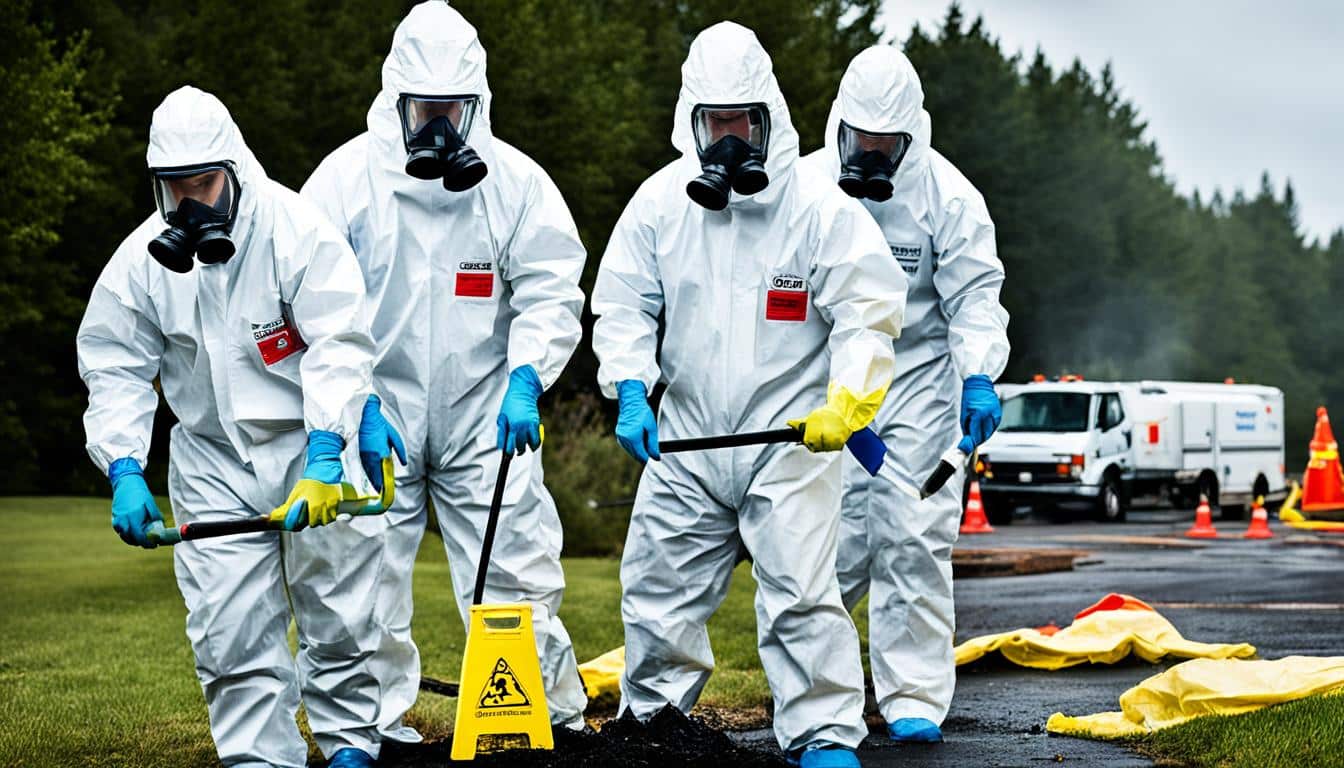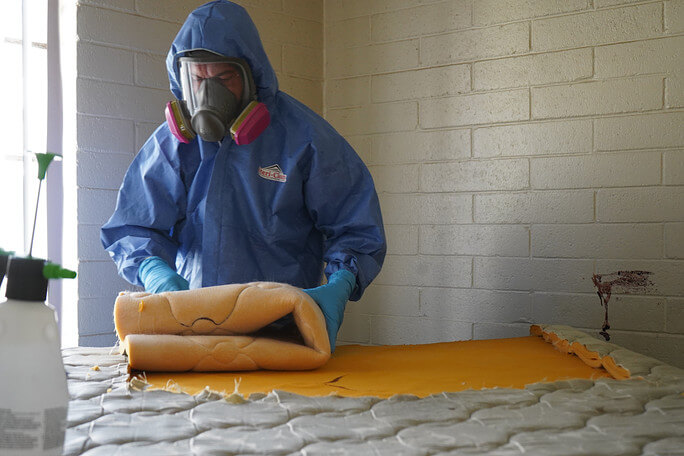Biohazard Removal: Safe Handling and Disposal of Hazardous Materials
Biohazard Removal: Safe Handling and Disposal of Hazardous Materials
Blog Article
Expert Biohazard Cleansing and Purification for Blood, Bodily Fluids, and Hazardous Materials
In the realm of biohazard cleaning and decontamination for blood, bodily liquids, and harmful materials, accuracy and experience are vital. The possible health threats related to direct exposure to biohazards emphasize the important requirement for thorough handling and complete clean-up. Specialized training outfits experts with the understanding and skills needed to deal with these dangerous situations successfully. Nevertheless, it is not merely concerning tidying up; the importance of employing appropriate decontamination strategies can not be overemphasized. As we browse the elaborate landscape of biohazard cleanup, recognizing the subtleties of regulations, conformity, and the specific equipment at play ends up being crucial in making sure a thorough and risk-free decontamination process.
Health And Wellness Risks of Biohazard Exposure
Direct exposure to biohazards poses significant health dangers that can result in serious effects for individuals and communities alike. Biohazards incorporate a variety of biological compounds, consisting of blood, bodily liquids, mold and mildew, germs, infections, and various other potentially contagious products. When people come into call with these biohazards, whether with crashes, improper handling, or environmental exposure, they encounter the danger of contracting severe illnesses or diseases.
Among the key wellness risks related to biohazard exposure is the transmission of transmittable diseases. Bloodborne virus such as HIV, hepatitis B and C, and various bacteria can be existing in biohazardous materials, presenting a straight threat to human wellness. Breathing in air-borne biohazards like mold and mildew spores or entering into call with polluted surface areas can additionally lead to breathing issues, allergic reactions, and various other unfavorable wellness effects.
Moreover, biohazard exposure can have lasting wellness effects, with some diseases showing up years after the initial contact (Blood Cleanup). For that reason, it is vital to prioritize appropriate biohazard cleansing and purification to mitigate these wellness risks and make sure the security of people and communities

Specialized Educating for Biohazard Clean-up
When it comes to managing biohazard cleaning effectively and securely, specialized training plays a fundamental function in making certain appropriate purification treatments are followed. Biohazard cleaning calls for particular understanding and abilities to efficiently alleviate threats connected with bloodborne microorganisms, physical fluids, and unsafe products. Professionals learnt biohazard cleaning undergo strenuous instruction on how to securely take care of, get rid of, and throw away biohazardous products to prevent contamination and exposure.
Specialized training for biohazard clean-up covers a variety of important topics, consisting of correct individual safety tools (PPE) use, bloodborne pathogen understanding, decontamination methods, and dangerous waste disposal methods. People learnt biohazard clean-up are geared up with the needed know-how to evaluate contamination levels, identify possible hazards, and carry out proper clean-up treatments in compliance with governing standards.
Constant training and education and learning are paramount in the field of biohazard cleanup to stay updated on the most recent decontamination innovations, safety and security methods, this website and policies. By investing in specialized training, biohazard cleaning experts can successfully react to emergency clean-up situations and guard both public health and the setting.
Value of Correct Purification Techniques
Using appropriate decontamination techniques is critical in biohazard clean-up to efficiently decrease and eliminate hazardous materials health dangers. Reliable decontamination not just ensures the elimination of noticeable traces of blood, bodily liquids, and other biohazards yet likewise targets unnoticeable microorganisms that might posture major health and wellness risks if not correctly eliminated. By adhering to strict decontamination methods, educated professionals can significantly decrease the risk of exposure to harmful microorganisms, infections, and bacteria that can lead to illness or infections.
Proper decontamination techniques involve the use of specific tools and disinfectants that are specifically made to neutralize biohazards effectively. Extensive cleansing and sanitation of contaminated areas are important to protect against the spread of virus and make sure a secure environment for owners. Furthermore, the proper disposal of biohazardous waste adhering to purification procedures is essential in protecting against contamination of various other surfaces or people.

Tools and Tools for Safe Clean-up
When dealing with blood, physical liquids, or dangerous materials, biohazard cleaning specialists rely on specialized equipment to minimize exposure risks and thoroughly sanitize the afflicted area. In addition, biohazard cleaning sets having disinfectants, absorbent materials, and biohazard bags are made use of to safely consist of and dispose of polluted items.
Advanced cleaning tools like hospital-grade disinfectants, HEPA-filtered vacuum cleaners, and misting makers are used to sterilize surfaces and remove biohazards efficiently. Specialized devices such as sharps containers and biohazard waste disposal containers are used to imp source securely take care of sharp objects and biohazardous waste materials. By utilizing the appropriate devices and tools, biohazard cleaning specialists can guarantee a detailed cleaning procedure that prioritizes security and lessens wellness risks for both employees and residents of the damaged room.
Laws and Conformity in Biohazard Cleaning
Appropriate adherence to guidelines and conformity requirements is paramount in biohazard cleaning to ensure the safety of both workers and the atmosphere. Government firms such as OSHA (Occupational Safety and Health And Wellness Management) and the EPA (Environmental Security Agency) have established details standards for biohazard clean-up treatments to lessen health dangers and ecological contamination. These guidelines cover a variety of aspects including the handling, transport, and disposal of biohazardous materials, in addition to the required training and safety devices needed for personnel associated with the cleanup process.
Biohazard cleansing business need to stay updated with these policies to ensure that their operations satisfy the called for security criteria. Failing to adhere to these laws can result in severe consequences, including fines, lawsuit, and threatening the health and wellness of individuals and the environment. By complying with rigorous laws and compliance actions, biohazard cleaning firms can efficiently mitigate threats and make sure a risk-free and complete clean-up process for all celebrations included.
Conclusion
In conclusion, biohazard cleansing and decontamination need customized training, appropriate techniques, and adherence to regulations. Direct exposure to blood, physical fluids, and harmful materials postures significant health and wellness dangers, making it vital to use the best tools and tools for secure cleaning. By adhering to strict protocols and see this here guidelines, specialists can properly minimize the threats connected with biohazard direct exposure and make certain the security of both themselves and others.
As we navigate the complex landscape of biohazard cleanup, recognizing the subtleties of laws, conformity, and the specialized devices at play comes to be essential in making sure a safe and detailed decontamination procedure. (Blood Cleanup)
When it comes to dealing with biohazard clean-up effectively and securely, specialized training plays a basic function in making certain correct decontamination treatments are adhered to.Utilizing proper decontamination methods is essential in biohazard clean-up to efficiently reduce and eliminate dangerous materials wellness threats. In addition, biohazard cleaning kits including anti-bacterials, absorptive materials, and biohazard bags are used to safely have and dispose of contaminated items.
Federal government companies such as OSHA (Occupational Safety And Security and Wellness Administration) and the EPA (Environmental Security Firm) have actually established certain standards for biohazard clean-up treatments to lessen wellness threats and ecological contamination.
Report this page